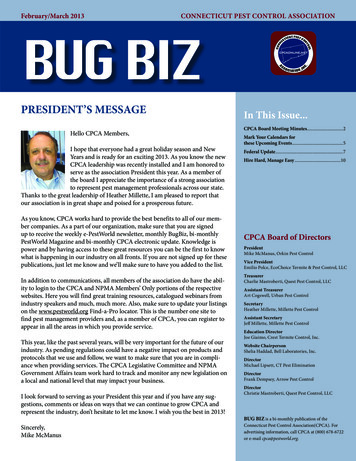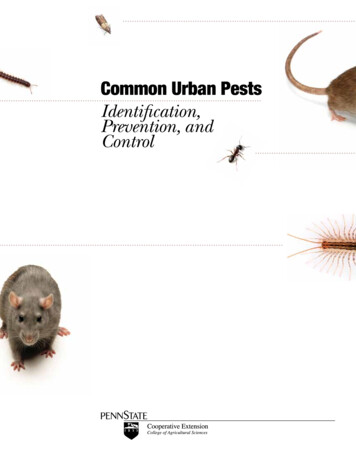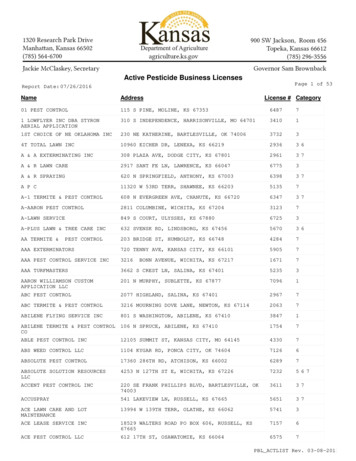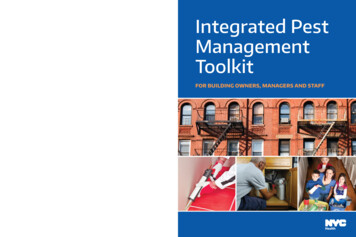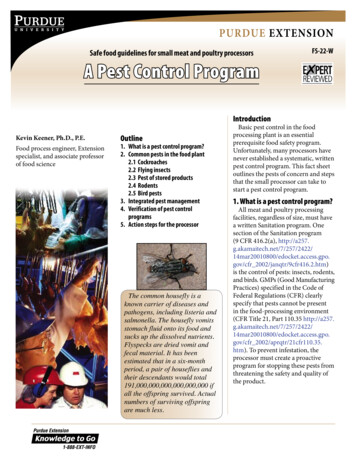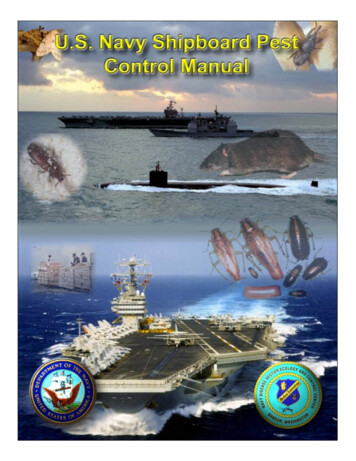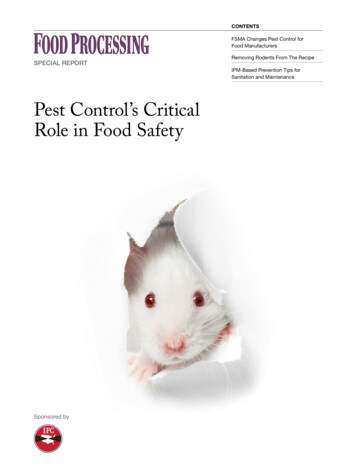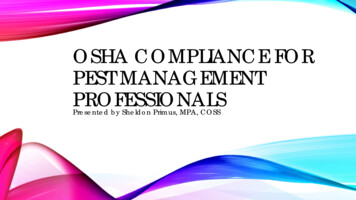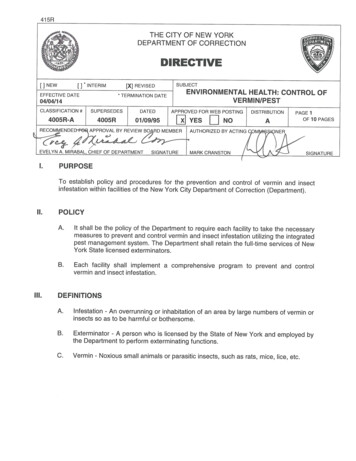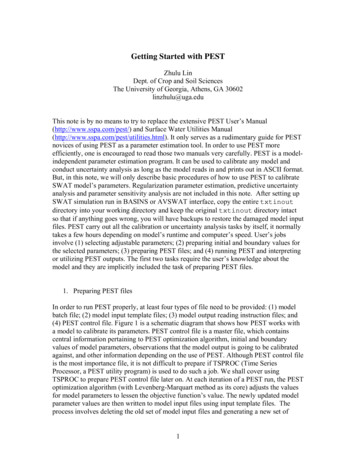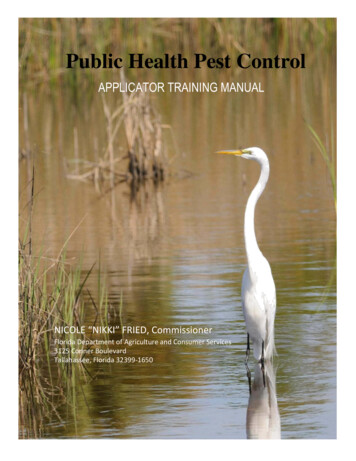
Transcription
Public Health Pest ControlAPPLICATOR TRAINING MANUALNICOLE “NIKKI” FRIED, CommissionerFlorida Department of Agriculture and Consumer Services3125 Conner BoulevardTallahassee, Florida 32399-1650
Public Health Pest ControlAPPLICATOR TRAINING MANUALNicole “Nikki” Fried, CommissionerFlorida Department of Agriculture and ConsumerServices 3125 Conner BoulevardTallahassee, Florida 32399-1650
AcknowledgementsIn accordance with Florida Administrative CodeChapter 5E-13.040, all persons who apply or supervisethe application of a pesticide intended to controlarthropods on property other than their own individualresidential or agricultural property must be licensed todo so with a Public Health Pest Control (PHPC) licenseor work under the supervision of a licensed applicator.In order to obtain the PHPC license, applicants mustscore 70% or above on two exams administered by theFlorida Department of Agriculture and ConsumerServices (FDACS): the General Standards (Core) examand the Public Health Pest Control exam. This PublicHealth Pest Control Manual, in conjunction with theCore Manual “Applying Pesticides Correctly” publishedby University of Florida, will provide generalinformation necessary to meet U. S. EnvironmentalProtection Agency and Florida standards forcertification as a pesticide applicator in the commercialcategory, Public Health Pest Control.The original Public Health Pest Control Manualwas prepared by Elisabeth Beck of the FloridaDepartment of Health and Rehabilitative Services(HRS), Office of Entomology. Technical assistance wasprovided by Dr. Andrew Rogers, retired, HRS, and thelate Dr. Maurice Provost, Florida Medical EntomologyLaboratory. The manual was edited and produced bythe IFAS Editorial Department under the supervision ofJoAnn Pierce. Appreciation is expressed to the U. S.Department of Health and Human Services (USHHS),and to extension specialists in neighboring states forvaluable ideas and visual aids. Credit is due to the latePaul J. Hunt, and John Gamble, East Volusia MosquitoControl District, and Thomas M. Loyless, Bureau ofEntomology and Pest Control (BEPC) of FDACS forphotographs of equipment and habitats.Thanks are due to Dr. Carlyle B. Rathburn,retired, John A. Mulrennan, Sr. Public HealthEntomology Research and Education Center for thesection on calibration of equipment, Dr. Philip Koehler,Department of Entomology and Nematology, IFAS,University of Florida, and William R. Opp, retired, LeeCounty Mosquito Control District for additionaltechnical assistance.The last edition was updated and revised in May2001 by Thomas M. Loyless, FDACS, with assistancefrom Edsel M. Fussell, Florida Keys Mosquito ControlDistrict, Mark Latham, Manatee County MosquitoControl District and Stephen Sickerman, FDACS(currently with the South Walton Mosquito ControlDistrict).This edition was updated and revised in 2011 byDr. Yongxing “Peter” Jiang, with assistance from Dr.Dave Daiker, Angela Weeks-Samanie, and Joe Claborn ofthe Florida Department of Agriculture and ConsumerServices, Dr. Jeff Stivers, Collier Mosquito ControlDistrict, and Dr. Rui-de Xue, Anastasia Mosquito ControlDistrict.The Department would like to extend a special thanks to Joe Claborn for thecover photograph of the St. Marks River and mosquito breeding habitats.i
Table of ContentsAcknowledgements . iIntroduction . 1History of Mosquito Control in Florida . 1Anti-Mosquito Association . 1Formed. 1Division of Entomology Created . 2Entomological Research Center Established . 2Mosquitoes . 3How to Recognize a Mosquito . 3Classification . 3Importance to Health and Economy . 3Mosquito Species in Florida. 4Mosquitoes and Their Production Sites in Florida . 5-12Identification . 12Larval Morphology . 15Adult Morphology . 15Some Problem Species of Mosquitoes in Florida . 16Common Problem Mosquitoes . 16Other Problem Mosquitoes . 16Mosquito Control Practice . 20Responsibilities of a Mosquito Control Director . 20Continuing education . 20Planning the Project. 21Equipment for Mosquito Control . 23Larviciding Equipment. 23Adulticiding Equipment . 23Calibration of ULV Machines and Checking Droplet Size . 23Calibration of Thermal Fog Equipment . 24Maintenance of Equipment . 24Methods of Mosquito Control . 24Premise Sanitation . 24Land and Water Management . 24Chemical Control . 25Larvicides . 25Adulticides. 25Other Control Methods . 26Legal Aspects of Mosquito Control. 27Public Relations and Managing Negative Impacts. 27Arthropods of Public Health Importance . 28Control of Other Arthropods by Mosquito Control Districts . 29Sand Flies . 30Stable Flies . 30Blind Mosquitoes . 30House Flies . 30Eye Gnats . 30Miscellaneous Insects . 30Glossary . 32Bibliography . 34
Figure 1. Florida and its counties
IntroductionThe State of Florida has made great progressin reducing the hordes of malaria-carrying Anophelesand salt marsh mosquitoes which, in years past,harassed visitors and Floridians alike. Many miles ofsalt marsh stretching down the east and west coasts ofthe State have been ditched or impounded by themosquito control districts, making the coastal areashabitable and opening them to development for housingand as tourist resorts.There is no question that the control of saltmarsh mosquitoes has made a major contribution to thedevelopment of the tourist industry in this state;without this control, tourists would not have repeatedlyvisited to enjoy the beaches and attractions. Figure 2gives a good picture of the relationship, showing thesteady rise in income from tourism plotted against thesteady decline of the major salt marsh pest mosquito,Aedes taeniorhynchus.Mosquitoes occur throughout the world,breeding in almost every known aquatic habitat exceptvery swift currents and in open bodies of water.Wherever they occur, mosquitoes are, for humans, atbest an annoyance and at worst vectors of deadlydiseases. Over 3,000 species have been describedworldwide and they display a broad range of habitats.Larvae may be found in such diverse places as thegrassy margins of ponds, land crab holes, and aquaticplants. Depending on the species, eggs may be laidsingly or in rafts, on water or on damp soil where theyhatch in subsequent flooding. Flight ranges also varyamong species from a few hundred feet to more thaneighty miles with favorable winds. Hibernation oroverwintering in different species may be in the eggstage, as larvae, or as adults. Each of these variationsamong species can affect the efficiency of any measureutilized to control them.Figure 2. Average numbertaeniorhynchus per light trapoffemaleAedesHistory of Mosquito Control in FloridaFlorida is the leading tourism destination inthe United States, and, in terms of dollars spent, it is thenumber one vacation destination in the world.Florida, with more than 1,200 miles ofcoastline, a warm subtropical climate, and heavyrainfall, produces an unusually rich fauna, including 80species of mosquitoes.We often forget that Florida was not always avacation paradise where people could escape forwarmth, recreation and relaxation. As little as 100 yearsago, many parts of Florida were considered unbearable,thanks in large part to legions of mosquitoes. Pestilenceand disease raged, and many people said the State couldnot be developed. When Congress was debating themerits of statehood for Florida, John Randolph ofVirginia stated that Florida could never be developed,nor would it ever be a fit place to live. He described theland as a "land of swamps, of quagmires, of frogs andalligators and mosquitoes."The battle with the mosquito, however, was along, tough fight and there were many casualties. Themosquito was such a plague when the Spaniards arrivedthat they named what today is Ponce de Leon Inlet,"Barro de Mosquitoes." Since the time of the earliestmaps, some of Florida's inlets, lagoons, and sectionshave borne the name Mosquito. In the 18th Century, thepart of Florida lying between the St. Johns River and thecoastal lagoons north of Cape Canaveral was called "TheMosquito Country," or "The Mosquitoes."In 1824, when Mosquito Country became acounty which included a large portion of peninsularFlorida, government officials could think of no moreappropriate name than "Mosquito County." Today, thatcounty is known as Orange County and is home for1
many of our major attractions in and around Orlando.For many years settlements in Florida wererestricted to the northern tier of the state. Thepeninsular portion of Florida was a series of swamps,lakes, rivers, and hammocks populated mostly byhoards of mosquitoes and other biting insects.Although northern Florida was settled, it wasanything but a pleasant place to live. It suffered fromdisease, hardship, and poverty; the major cities ofJacksonville, St. Augustine, Tallahassee and Pensacolawere known as the "malaria belt."Summer routinely brought swarms ofmosquitoes and deadly fevers to the region. Commercewas seriously curtailed and those who could afford itfled to the north for relief. Those forced to stay behindfaced the threat and certainty of disease. One of theworst sieges of disease was the yellow fever epidemic in1877 in Jacksonville and Fernandina Beach. It wasdescribed by historians as the State's worst holocaust.Fernandina Beach, with a population of 1,632, had1,146 persons ill with the fever. Twenty-four died. In1887, yellow fever epidemics raged in Key West,Tampa, Plant City, and Manatee. The 1888 epidemic inJacksonville saw 10,000 persons (out of a population of26,700 in Duval County) flee the city in carriages, drays,wagon trains, and ships.All of that has changed thanks to mosquitocontrol. Consider, for example, the success story ofmosquito control at Sanibel Island. On Florida's rapidlyexpanding southwest coast, Sanibel is one of the resortjewels our State offers, fantastic weather, incrediblesunsets, great beaches, and fine resorts. Sanibel has itall. But without mosquito control, it would be virtuallyuninhabitable. In fact, the island was once so heavilyinfested with mosquitoes that bred in the vast grassymarshes that the local postman had to make his roundsin July dressed like an Eskimo in a parka and netting.Control District in 1935. By 1975, there were 52mosquito control districts in Florida, and that numberhas remained fairly constant to the present day.From the depression year of 1933 until fundswere withdrawn in 1941, many malaria control projectswere performed with funding from the Civil WorksAdministration, Emergency Relief Administration of theWorks Progress Administration. During this period,more than 1,500 miles of drainage ditches were dugthroughout the state to eliminate mosquito breedinghabitats.In 1941, a Bureau of Malaria Control wascreated within the Division of Health and in 1942, theU.S. Public Health Service set up the first MalariaControl in War Areas project in Florida nearTallahassee. Similar projects were then establishedaround all military bases in the state. A program of DDTresidual house spraying in malarious areas of Floridawas supported by U.S. Public Health Funds from 1945through 1949.Division of Entomology CreatedIn 1946, the Bureau of Malaria Control wasabolished and a Division of Entomology was createdwithin the Bureau of Sanitary Engineering. In 1953, theDivision was raised to Bureau status. In 1976, theBureau of Entomology became the Office of Entomologyand in 1986, became Entomology Services in theDepartment of Health and Rehabilitative Services. Theprogram was moved to the Department of Agricultureand Consumer Services (DACS) in 1992, where it is nowknown as the Bureau of Scientific Evaluation andTechnical Assistance (BSETA). The functions of theBSETA include promoting control of insects of publichealth importance, serving as advisors and consultantsfor mosquito control districts, and administering allstate funds appropriated for nonagricultural arthropodcontrol work. State laws were passed in 1925, 1929,and 1941 which set up methods for establishing selftaxing mosquito control districts and in 1949, a Statelaw was passed that provided State aid to districts inthe form of insecticides, materials, equipment,personnel, and vehicles.In 1953, the State Legislature passed a secondState aid law whereby any board of countycommissioners or mosquito control district that placesfunds in its budget for control of "arthropods of publichealth importance", would, upon proper certification,receive funds directly from the State of up to 75 percentof the funds appropriated by the county or district.These funds were to be used for permanent controlmeasures; additional appropriations were given asmatching funds for either permanent or temporarycontrol measures.This act has been amended several times. Atpresent, it provides that a county or district shall beeligible, upon approval of the Department of Agricultureand Consumer Services, to receive state funds. Theamount and type of State aid currently available tomosquito control agencies is described in Chapter 5E-Anti-Mosquito Association FormedNo organized effort was made to controlmosquitoes in Florida as a way of preventing malariauntil World War I when the U.S. Army, U. S. PublicHealth Service, and the State Board of Health set up aprogram of drainage and larviciding at Camp Johnson,near Jacksonville. In 1919, the State Board of Health, thecity of Perry, and the Burton Swartz Cypress Companyjointly set up a malaria control project in the city ofPerry, one of the most malarious areas of the State. Atthat time the Perry project was one of the largestmalaria control projects in the country and was the firstnon-military control project in Florida.Mosquito control in Florida was given impetusin 1922 by the formation of the Florida Anti-MosquitoAssociation (FAMA) (now known as the FloridaMosquito Control Association, FMCA), with Dr. J. Y.Porter, the State's first Health Officer, serving as itspresident. The Indian River County Mosquito ControlDistrict was established in 1925, followed by St. LucieMosquito District in 1926, Broward County MosquitoControl District in 1934 and Dade County Mosquito2
13. 030 Florida Administrative Code (F.A.C.)Entomology Research and Education Center (JAMSPHEREC), formally the West Florida ArthropodResearch Laboratory, was established at Panama City in1963. Its primarily mission was to study the biology andcontrol of the "dog fly," known elsewhere as the stablefly (Stomoxys calcitrans), which plagues people on theGulf beaches in summer, and to test the efficacy ofvarious insecticides on mosquitoes and otherarthropods. In 1992, JAMS PHEREC was transferred toFlorida Agricultural and Mechanical University, Collegeof Engineering Sciences, Technology and Agriculture,but its overall mission remains unchanged.Entomological Research Center EstablishedIn 1953, the legislature appropriated money toestablish the Entomological Research Center at VeroBeach to study the biology and control of arthropods ofpublic health importance in Florida. The center wasdedicated in 1956 and has become world renowned forthe excellence of its facilities and its research. In 1973,the name was changed to the Florida MedicalEntomology Laboratory and, in 1979, it was transferredto the University of Florida, Institute of Food andAgricultural Sciences.The John A. Mulrennan, Sr. Public HealthMOSQUITOESletter. Mosquito publications, however, often abbreviatethe genus name using a two-letter abbreviation, forinstance, Ae. for Aedes and Cx. for Culex. The secondname is a specific name and begins with a small letter.Together they form the species name which is alwayseither italicized or underlined (to indicate italics). Theclassification of the mosquito which transmittedmalaria in the southeastern United States is shownbelow:How to Recognize a MosquitoMosquitoes are insects with long slenderbodies, narrow wings with a fringe of scales on the hindmargin and along the veins, and long, very thin legs. Infemales, the elongate proboscis is firm and usuallyadapted for piercing and sucking blood. Malemosquitoes cannot suck blood, and survive on nectar.Females are also required to feed on nectar of variousplants to obtain sugar for energy, but rely on a bloodmeal for egg-laying.There are four life stages: egg, larva, pupa, andwinged adult. Eggs may be laid singly or in rafts,deposited in water, on the sides of containers wherewater will soon cover them, or on damp soil where theymust undergo a maturing process before they can hatchwhen flooded by rainfall or high tides. Mosquitoes of thegenus Mansonia deposit their eggs on the underside,and, less so, on the upper side of floating aquatic plantssuch as water lettuce and water hyacinth. After the eggshatch, the larvae or wrigglers begin to feed on verysmall plant and animal particles, going through fourgrowth stages or instars before becoming pupae. Withthe exception of species in the genera Mansonia andCoquillettidia, larvae of other species all breathe air atthe surface of the water. Species of Mansonia andCoquillettidia, in contrast, have a sharp pointed siphonwhich pierces the roots and stems of aquatic plants toobtain oxygen from the plant. The pupal or tumblerstage is comparatively brief, does not feed, and is activeonly if disturbed. Upon maturation, the pupa emergesfrom the surface of the water, splits the chitinous pupalskin and the adult emerges. After a brief time on thesurface to dry its wings, the adult flies away.Kingdom - Animalia (all animals)Phylum - Arthropods (all animals with paired,jointed appendages andexoskeletons)Class - Insecta(all insects; three main bodydivisions and six legs)Order - Diptera(true flies, all two-winged flieswith the hind wings reducedto knobbed structures calledhalteres)Family - Culicidae(all mosquitoes)Genus - AnophelesSpecies - Anopheles quadrimaculatus Say (Say is theperson who first described the species)Currently, 80 species of mosquitoes, belongingto 12 different genera, have been recorded in Florida.These mosquitoes inhabit a wide variety of aquatichabitats, and the biology of each of these species isunique in some way. Unique distinctions betweenspecies include larval habitat, host preferences, andflight ranges, and will be discussed in more detail in thesection focusing on various mosquito species. Thedifferences in appearance (morphological differences)are discussed in the section on identification.ClassificationIn order to make it clear exactly which animalamong the many kinds one is speaking or writing about,scientists have devised a system of classification andnaming in which each kind of animal known to scienceis given a name consisting of two words. The first nameis the name of the genus and is written with a capitalImportance to Health and EconomyIn years past, malaria, yellow fever, anddengue were present in the State in epidemicproportions. Through mosquito control, these diseasesare now no longer endemic. However, Anopheles3
quadrimaculatus, which transmits malaria and Aedesaegypti, which vectors both yellow fever and dengue,are still present in large numbers, and if personscarrying the disease in their bloodstreams should comeinto Florida from other areas, it would be possible formosquitoes to bite them and become infected. In thisway, a new cycle of these diseases could begin.Although secondary infections may resultfrom scratching mosquito bites, and there are peoplewho are allergic to the bites, the chief medical concernin Florida at the present time is the possibility of anarthropod- borne encephalitis epidemic. Viruses ofEastern Equine Encephalitis, Western EquineEncephalitis, St. Louis Encephalitis, CaliforniaEncephalitis and Venezuelan Equine Encephalitis havebeen found in mosquitoes in the State.Madison and Escambia Counties); the lower St. JohnsRiver areas (Duval, Volusia, Flagler, Putnam and ClayCounties); and the green swamp region area (Lake,Orange, Pasco, Polk, Osceola, Pinellas, Hillsborough andManatee Counties).A vaccine is available for horses, but not forhumans. Preventive measures should include effectivemosquito control and avoidance of mosquito bites byusing insect repellent, wearing protective clothing, andstaying indoors while mosquitoes are most active.St. Louis Encephalitis St. LouisEncephalitis (SLE) was first recognized in the vicinity ofSt. Louis, Missouri and the neighboring St. Louis Countyin 1933 when an encephalitis epidemic broke out. Over1,000 cases were reported to the local healthdepartments and the newly constituted NationalInstitute of Health. St. Louis encephalitis virus (SLEV), aflavivirus, is one mosquito-transmitted viral diseasethat is of great medical importance in North America.During summer, SLEV is maintained in a mosquito-birdcycle, with periodic amplification by birds and Culexmosquitoes.Normally less than 1% of SLEV infections inhumans are clinically apparent and the vast majority ofinfections remain undiagnosed. The occurrence andseverity of SLE in humans is strongly dependent on age.The case fatality rate in Florida SLE epidemics hasranged from 4-30 percent. Deaths were almostexclusively among people age 50 and older. It is notuncommon for those surviving severe cases of SLE tosuffer long-term residual neurological damage, whichinclude paralysis, memory loss, or deterioration of finemotor skills.Major SLE outbreaks occurred in Florida in1959, 1961, 1962, 1977 and 1990. The epicenter of theoutbreaks in 1961 and 1962 was the Tampa area. In1961, there were 25 cases with 7 deaths and in thefollowing year, there were 222 cases with 43 deaths.One very interesting discovery made at the time wasthat the SLE virus was vectored by Culex nigripalpus, aspecies which had not been previously implicated indisease transmission. In other parts of the United States,SLE is transmitted by Culex quinquefasciatus and Culextarsalis. In addition to the illnesses and deaths causedthis epidemic also greatly reduced tourism business.The reductions were estimated to be as high as 40million, which added an enormous economic loss to thehuman loss and suffering.Eastern Equine Encephalitis EasternEquine Encephalitis (EEE) is an enzootic disease thatwas first recognized in Massachusetts, in 1831 when 75horses died of an encephalitic illness. The casual agent,Eastern Equine Encephalitis virus (EEEV), is analphavirus that was first isolated from infected horsebrains in the 1930s and currently occurs in focallocations of the eastern United States including Florida.EEE is capable of infecting a wide range of animalsincluding mammals, birds, reptiles and amphibians. Thevirus is maintained in natural cycles involving birds andCuliseta melanura in freshwater swampy areas with apeak of activity between May and August. In this usualcycle of transmission, the virus does not escape fromthe swampy areas because the mosquito species,Culiseta melanura, prefers to feed upon birds and doesnot usually bite humans or other animals. However,transmission of EEEV to mammals occurs via bridgevectors because they bring the virus from avianpopulations to mammalian populations. These bridgevectors include Coquillettidia perturbans, Aedesatlanticus, Culex nigripalpus, Cx. quinquefasciatus andAedes solicitants. These species feed on both birds andmammals and can transmit the virus and cause diseasein people, horses, dogs and some birds such aspheasants, quail, ostriches and emus.Most persons infected with EEEV have noapparent illness. However, symptoms of severe cases ofEEE include sudden onset of headache, high fever, chills,and vomiting. The illness may then progress todisorientation, seizures, or coma. EEE is one of the mostsevere mosquito-transmitted diseases in the UnitedStates with approximately 33% mortality andsignificant brain damage in most survivors.Despite there having been only 81 humancases documented in Florida in the past fifty years(1957-2008), the State averages over 70 reportedequine cases each year. In years when conditions favorthe spread of EEE, the number of reported cases canexceed 200, with over 90% of the affected horses dying.The distribution of EEE cases have predominantly beenin areas north of Lake Okeechobee, includ
(currently with the South Walton Mosquito Control District). This edition was updated and revised in 2011 by Dr. Yongxing "Peter" Jiang, with assistance from Dr. Dave Daiker, Angela Weeks-Samanie, and Joe Claborn of the Florida Department of Agriculture and Consumer Services, Dr. Jeff Stivers, Collier Mosquito Control

